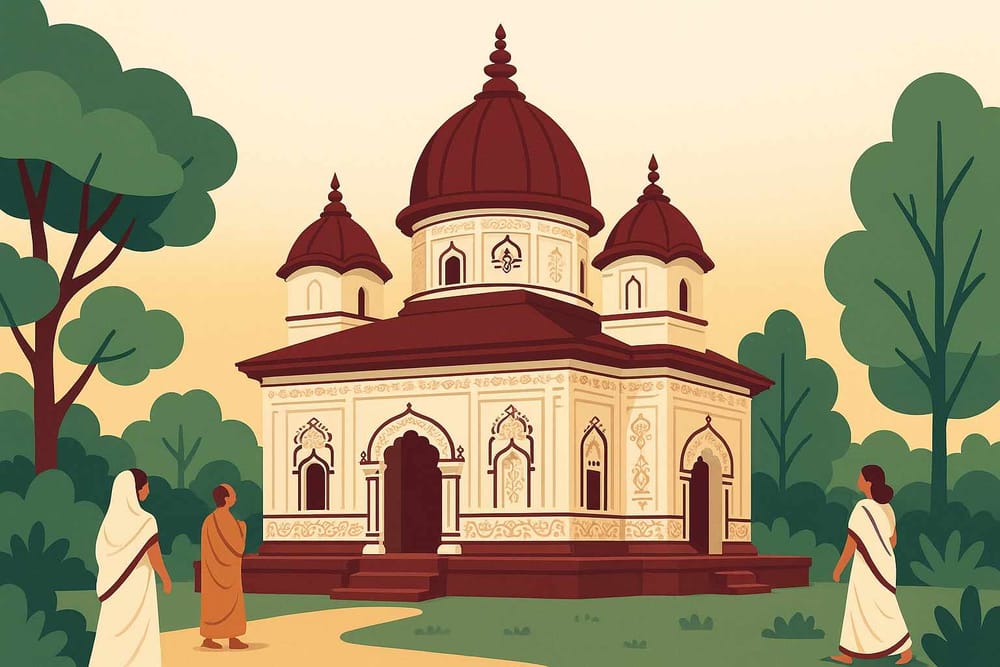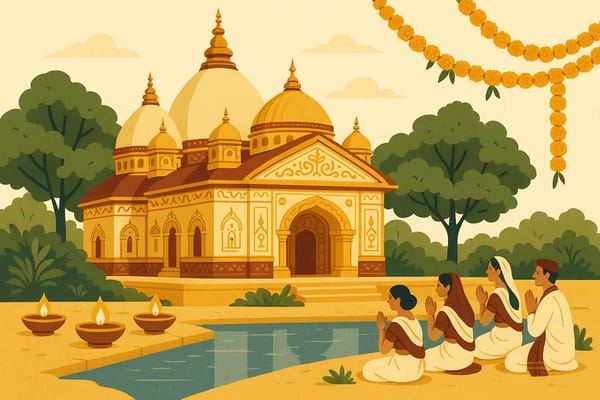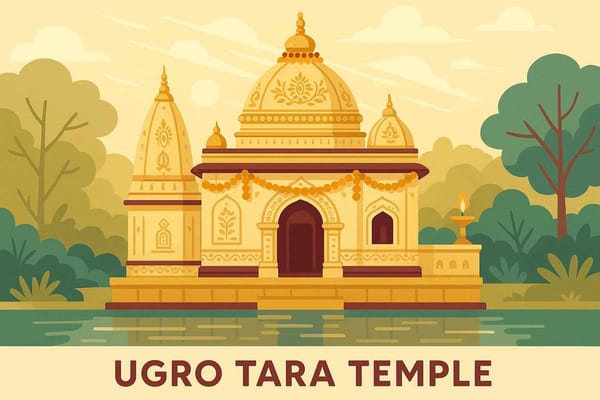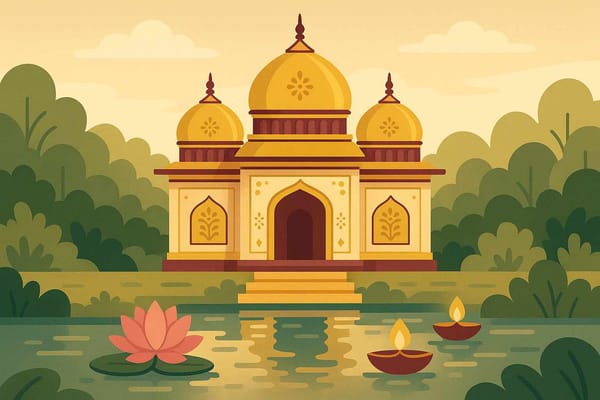
Ugro Tara Temple- History- Architecture- Significance: Explore Now
In the heart of bustling Guwahati, where the mighty Brahmaputra flows with ancient secrets, lies a place of quiet, immense power – the Ugro Tara Temple. It’s not a place of towering gopurams or grand halls. Instead, its magic lies in its simplicity, its deep-rooted history, and the palpable presence of the Divine Mother. Visiting this sacred space, or Ugratara Devalaya as it is lovingly called, feels less like a trip and more like a homecoming for the soul.
Echoes of the Past: The Story Behind the Temple
Every brick of this temple seems to whisper tales from centuries ago. It was built back in 1725 AD by the great Ahom King, Siva Singha. The Ahom dynasty had a deep reverence for Shakti worship, and this temple is a beautiful testament to their devotion. The royal patronage of spiritual centres was a tradition across India, shaping our cultural landscape. The Ahom kings, much like the rulers of Mewar who patronised magnificent structures like the Jagdish Temple, were instrumental in building these spiritual anchors for the people.
But the story of Ugratara goes even deeper, into the very fabric of Hindu mythology. Legend has it that this is one of the revered Shakti Peethas, the sacred spot where the navel of Goddess Sati fell to earth. This connection makes it an incredibly potent centre of divine feminine energy. The air here is thick with devotion, carrying the prayers of countless souls who have sought solace and strength from the Goddess.
A Different Kind of Darshan: The Unique Architecture
When you step into the sanctum sanctorum (the Garbhagriha), you might be surprised. Unlike most Hindu temples, you won't find a traditional idol of the Goddess. Instead, the focus of worship is a small pit filled with water, which is revered as the Goddess herself. This formless worship is a powerful reminder that the divine is everywhere, in every element of nature.
The temple itself is a beautiful example of traditional Ahom architecture, with its distinctive sloping roof. Though partially damaged in the great earthquake of 1897, it has been lovingly restored over the years. Right next to the main temple, there is a Shivalaya, honouring Lord Shiva. Behind them both lies the serene Jorepukhuri tank, its calm waters reflecting the sky. This twin tank, also built by King Siva Singha, is considered holy, and its presence adds to the tranquil atmosphere of the entire complex.
Maa Ugratara: The Fierce Protector
So, who is Ugratara? The name itself gives a clue – ‘Ugro’ means fierce or powerful. She is a powerful form of Maa Parvati, a protector who shields her devotees from all evil and negative forces. People come here with hearts full of hope, praying for courage to overcome life's obstacles, for wisdom, and for success in their endeavours. It is believed that her fierce form is reserved for destroying negativity, while her grace for her devotees is boundless.
The temple is a significant centre for Tantric practices, and its rituals are unique. Traditionally, animal sacrifices have been a part of the worship, especially during Durga Puja, to appease the Goddess. This is a practice rooted in ancient traditions and is approached with deep reverence by the devotees.
When the Temple Comes Alive: Festivals and Rituals
While the temple is a peaceful sanctuary on any given day, it truly comes alive during festivals. Durga Puja and Navratri are celebrated with incredible fervour. The entire place is decorated, lamps are lit, and the sound of prayers fills the air. It’s a sight to behold, as thousands of devotees gather to catch a glimpse of the Divine Mother and seek her blessings. Manasa Puja, a festival honouring the serpent goddess, is another important event that showcases Assam's rich local traditions.
The daily rituals are simple yet profound, involving prayers and offerings of flowers, fruits, and betel leaves. The temple is usually open from the early hours of the morning, around 5:30 AM, until about 8:00 PM in the evening, allowing devotees ample time for darshan.
A Guide for Your Spiritual Journey
If you are planning a visit, many questions might come to your mind. People often wonder what makes this temple so incredibly special among the many sacred sites in India. Its uniqueness lies in its formless worship and its deep connection to the Shakti Peetha legend, making it a focal point of immense spiritual energy.
Many are also curious about the history and the story behind the sacred Jorepukhuri tank. As we've shared, the temple's origins are tied to the Ahom dynasty, but its spiritual roots go back to the very beginnings of Shakti worship. The pond is not just a body of water; it's considered a living part of the temple's divinity, with devotees often using its water for purification before prayers.
For those planning a trip, the temple is located in the Uzan Bazaar area of Guwahati, making it easily accessible. The best time to experience its spiritual vibrancy is during major festivals, but a visit on any ordinary day offers a chance for quiet reflection and a deep, personal connection with the Goddess.
Your Path to Bhakti & Beyond with Bhaktilipi
Understanding the deep stories and traditions behind sacred places like the Ugro Tara Temple is at the heart of what we do at Bhaktilipi. We strive to bring India’s rich devotional heritage closer to you, simplifying ancient wisdom for modern life. Our platform is a space to explore spirituality in a way that resonates with you.
To continue this journey of discovery, we invite you to connect with us. Subscribe to our YouTube channel for beautiful devotional content, follow us on Facebook and Instagram for daily inspiration, and join our newsletter for timeless stories and traditions delivered to your inbox.
A Final Word from the Heart
The Ugro Tara Temple is more than just a historical monument; it's a living, breathing centre of faith. It weaves together threads of history, powerful legends, and unwavering devotion. Whether you go there seeking blessings, to admire its unique character, or simply to find a moment of peace, you will leave with your spirit touched. May your visit fill your heart with peace, inspiration, and a deeper connection to the divine feminine energy that nurtures us all.
A passionate group of people dedicated to preserving India's knowledge of Dharma, Karma, and Bhakti for ourselves and the world 🙏.
Comments
Related in

Ugro Tara Temple Mystique: Explores Cultural Significance
In the middle of Guwahati's busy streets, where life moves at a whirlwind pace, there is a place of profound stillness and immense power. It's a place where you can feel the energy in the very air you breathe. I'm talking about the Ugratara

Explore Ugro Tara Temple- Culture and History Journey
In the bustling heart of Guwahati's Uzan Bazar, amidst the familiar sounds of city life, there lies a place of profound stillness and immense power. It's the Ugro Tara Temple, or Ugratara Devalaya as it is fondly known. This isn't just another temple; it’

Exploring the Mystical Ugro Tara Temple: Spirituality and Culture Await
There are some places of worship that you visit, and then there are some that visit you, leaving a mark on your soul long after you’ve left. In the bustling Uzan Bazar of Guwahati, tucked away from the city's hum, lies such a sanctuary – the Ugro Tara
